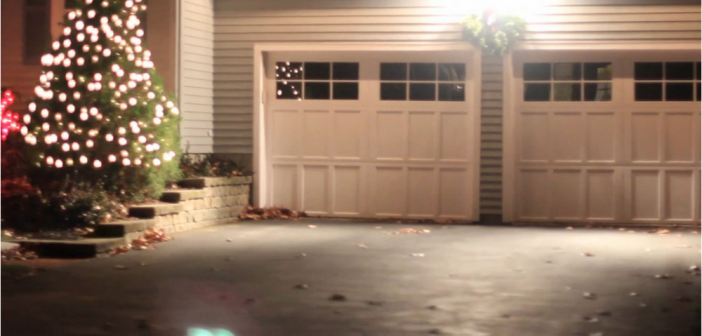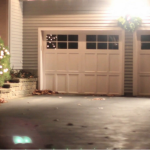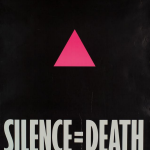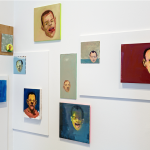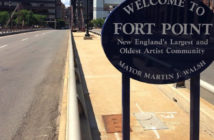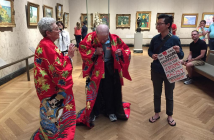2013's end is nigh, and we at BR&S can hardly believe it. We're full of pride over what we've been able to accomplish and cover in our first full calendar year since our relaunch. But, much like in our diverse arts and cultural sector, our blog and journal can sometimes have a blink-and-you-missed-it feeling. Over the next few days, each member of the BR&S staff will be posting their favorite pieces of writing from the year, occasionally offering up insights as to their personal significance.
.....................................................................................................
Inside Out: An elephant, a bear, a butterfly
By Siobhan Landry
My favorite post this year came after only three weeks into 2013. In this essay from our then Inside Out artist-in-residence Siobhan Landry, an issue of significant personal loss is weighed against a diaristic creative impulse. Drawing on a public reading by Etgar Keret, she compares writing and documentary noting that "[s]ince both revolve around narrative, and narrative revolves around plot, both are an attempt to understand the past in order to comprehend the future. They are an expression of a kind of yearning, and yearning is connected to the past and to the future, but not to the now, not to the concrete." By offering a glimpse into her personal life, Siobhan addressed the limitations of art and its occasional failure to act within the now, for both an audience and its maker.
Queer Codes in the Public Sphere: A lecture by Avram Finkelstein
and
Queer Codes in the Public Sphere: Q&A
 Silence=Death, ACT UP New York. Courtesy of the New York Public Library, Manuscripts and Archive Division.
Silence=Death, ACT UP New York. Courtesy of the New York Public Library, Manuscripts and Archive Division.It is rare to meet a cultural icon, one to whom you feel personally indebted. So while attending Avram Finkelstein's lecture to a class at the University of Massachusetts Boston in late February I was suitably awed. What was exciting for me, however, was to learn about his history—both as an artist and as a gay man—from him. As my mind was already lingering with thoughts of loss and disconnectedness, I was most moved by Avram's final statements describing his frustrations with and inability to articulate the loss of life during the AIDS crisis, along with the hope to have it properly historicized. He notes that "after a certain point when people asked me about the AIDS crisis and I would try to explain it to them I began to feel more and more like an immigrant trying to talk about the old country. Or in more extreme cases, like a soldier trying to explain the terrors of war. ...There is a tremendous movement among young queer artists to try to piece together this missing chunk of our history. All of the people trying to reimagine the work that might have happened if these people hadn’t died or trying to connect this moment to a post-AIDS world. Grappling with the idea that there are so many less older gay men than there would have been. What does that mean to the tribe? Communities need our own touchstones, we need our social histories, we need our elders, we need the folk language of queerness, which might be the thing that’s missed in the academic vision of what being queer is. To be queer in the world is to find a place for yourself. Frequently it’s about looking for yourself, looking for your face in the public discourse. Or reading between the lines to find it."
We posted the full transcript of the lecture in our March Journal, along with the Q&A session afterwards, which we snuck into a link at the end of the article. Not many people saw the Q&A post, so I've linked to it above (I highly recommend reading both).
Queering the ICA
By Evan Smith
 Installation view of Steve Locke: there is no one left to blame at the Institute of Contemporary Art/Boston. Photo: John Kennard
Installation view of Steve Locke: there is no one left to blame at the Institute of Contemporary Art/Boston. Photo: John KennardOne of the reasons that I love this piece is because it was a long time coming—Evan first expressed to us an interest in writing about this subject roughly a year ago. The overlapping exhibitions of Steve Locke, Mary Reid Kelley, and Amy Sillman presented him with an opportunity to advance a well-considered discussion on the ICA's apparent curatorial perspective of "how art today fuses the personal to the social, with a deep investment in queer and feminist ideas."
The final sentiments from Avram's lecture about "looking for your face in the public discourse" were echoed here by Evan, largely by drawing on Locke's work and the educational programming related to his exhibition. Evan reasserts this by accrediting responsibility to institutions and curators in the role they play in the aforementioned historicization of social movements and the obligation they carry in properly communicating the social context of exhibitions and individual pieces of art. To this point Evan writes, "If an artist’s role is to 'show people what they need to see,' it’s the curator’s role to facilitate that encounter, to open it up to a wider audience, and to provide context to the artist’s personal language. It means going beyond a hermetic relationship to the artists’ practices, ensuring that their ideas "touch ground" and make contact with the people who could most benefit from them. What the ICA has done by consistently showing work of often-marginalized members of society is fantastic. What they still can do by addressing these contexts in a way that is accessible to a broad audience is where the institution can make history."
- Siobhan Landry, now they have it, still from video, 2012.
- Silence=Death, ACT UP New York. Courtesy of the New York Public Library, Manuscripts and Archive Division.
- Installation view of Steve Locke: there is no one left to blame at the Institute of Contemporary Art/Boston. Photo: John Kennard

